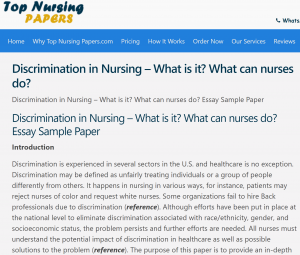Introduction Discrimination is experienced in several sectors in the U.S. and healthcare is no exception. Discrimination may be defined as unfairly treating individuals or a group of people differently from others. It happens in nursing in various ways, for instance, patients may reject nurses of color and request white nurses. Some organizations fail to hire Back professionals due to discrimination (reference). Although efforts have been put in place at the national level to eliminate discrimination associated with race/ethnicity, gender, and socioeconomic status, the problem persists and further efforts are needed. All nurses must understand the potential impact of discrimination in healthcare as well as possible solutions to the problem (reference). The purpose of this paper is to provide an in-depth discussion of discrimination in nursing including impact and possible solutions.
Order for a Health Reform Plan paper
Are you looking for such an essay? Order an original nursing essay assignment from the top nursing papers writers.Different Contexts of Discrimination in Nursing
Discrimination can happen in a different context in nursing care, such as between nurses and patients and among nurses themselves. Discrimination happens among nursing peers. Nurses often experience acts of discrimination from fellow nurses who have prejudiced or ignorant attitudes and beliefs about one or several of their personal characteristics (reference). Discrimination can culminate into dangerous assumptions about other people based on age, race, or gender. Discrimination among nurses may be expressed through microaggressions or racial slurs. Microaggressions involve actions and comments that reflect a bias against certain types of people or groups of people (reference). Discrimination among nurses may be based on particular characteristics such as age, race, gender, religion, political affiliation, and others.
Discrimination may also occur between nurses and patients. Nurses have been reported holding stereotypes about patients that can in turn affect the quality-of-care delivery. On the other hand, patients may hold prejudiced perceptions about nurses causing them to mistreat those attending to them (reference). Therefore, both patients and nurses should be responsible to ensure they avoid discrimination against others.
microaggressions or racial slurs. Microaggressions involve actions and comments that reflect a bias against certain types of people or groups of people (reference). Discrimination among nurses may be based on particular characteristics such as age, race, gender, religion, political affiliation, and others.
Discrimination may also occur between nurses and patients. Nurses have been reported holding stereotypes about patients that can in turn affect the quality-of-care delivery. On the other hand, patients may hold prejudiced perceptions about nurses causing them to mistreat those attending to them (reference). Therefore, both patients and nurses should be responsible to ensure they avoid discrimination against others.
